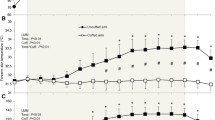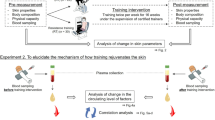Abstract
The ability to control skin blood flow decreases with primary aging, making older adults less able to adequately thermoregulate and repair cutaneous wounds. Lifestyle factors such as physical activity, diet, and smoking might interact with the aging process to modulate “normal” age-associated changes in the cutaneous microcirculation. The main focus of this brief review is the effects of exercise training on the control of skin blood flow in older adults.
Similar content being viewed by others
References
Algotsson A, Nordberg A, and Winblad B. Influence of age and gender on skin vessel reactivity to endothelium-dependent and endothelium-independent vasodilators tested with iontophoresis and a laser Doppler perfusion imager. J Gerontol A Biol Sci Med Sci 50: M121–127, 1995.
Black MA, Green DJ, and Cable NT. Exercise prevents age-related decline in nitricoxide-mediated vasodilator function in cutaneous microvessels. J Physiol 586: 3511–3524, 2008.
Boegli Y, Gremion G, Golay S, Kubli S, Liaudet L, Leyvraz PF, Waeber B, and Feihl F. Endurance training enhances vasodilation induced by nitric oxide in human skin. J Invest Dermatol 121: 1197–1204, 2003.
Braverman IM. The cutaneous microcirculation. J Investig Dermatol Symp Proc 5: 3–9, 2000.
Cracowski JL, Minson CT, Salvat-Melis M, and Halliwill JR. Methodological issues in the assessment of skin microvascular endothelial function in humans. Trends Pharmacol Sci 27: 503–508, 2006.
Evans E, Rendell M, Bartek J, Connor S, Bamisedun O, Dovgan D, and Giitter M. Thermally-induced cutaneous vasodilatation in aging. J Gerontol 48: M53–57, 1993.
Farage MA, Miller KW, Berardesca E, and Maibach HI. Clinical implications of aging skin: cutaneous disorders in the elderly. Am J Clin Dermatol 10: 73–86, 2009.
Franzoni F, Galetta F, Morizzo C, Lubrano V, Palombo C, Santoro G, Ferrannini E, and Quinones-Galvan A. Effects of age and physical fitness on microcirculatory function. Clin Sci (Lond) 106: 329–335, 2004.
Franzoni F, Plantinga Y, Femia FR, Bartolomucci F, Gaudio C, Regoli F, Carpi A, Santoro G, and Galetta F. Plasma antioxidant activity and cutaneous microvascular endothelial function in athletes and sedentary controls. Biomed Pharmacother 58: 432–436, 2004.
Green DJ, Carter HH, Fitzsimons MG, Cable NT, Thijssen DH, and Naylor LH. Obligatory role of hyperaemia and shear stress in microvascular adaptation to repeated heating in humans. J Physiol 588: 1571–1577, 2010.
Hagisawa S, Barbenel JC, and Kenedi RM. Influence of Age on Postischemic Reactive Hyperemia. Clin Phys Physiol M 12: 227–237, 1991.
Heylen E, Simon B, Guerrero F, Elkaim JP, Saiag B, and Mansourati J. Reactive hyperaemia in the forearm skin of highly trained windsurfers. Int J Sports Med 26: 822–826, 2005.
Ho CW, Beard JL, Farrell PA, Minson CT, and Kenney WL. Age, fitness, and regional blood flow during exercise in the heat. J Appl Physiol 82: 1126–1135, 1997.
Hodges GJ, Sharp L, Clements RE, Goldspink DF, George KP, and Cable NT. Influence of age, sex, and aerobic capacity on forearm and skin blood flow and vascular conductance. Eur J Appl Physiol 109: 1009–1015, 2010.
Hodges GJ, Sharp L, Stephenson C, Patwala AY, George KP, Goldspink DF, and Tim Cable N. The effect of 48 weeks of aerobic exercise training on cutaneous vasodilator function in post-menopausal females. Eur J Appl Physiol 108: 1259–1267, 2010.
Holowatz LA, and Kenney WL. Peripheral mechanisms of thermoregulatory control of skin blood flow in aged humans. J Appl Physiol 109: 1538–1544, 2010.
Holowatz LA, Thompson-Torgerson C, and Kenney WL. Aging and the control of human skin blood flow. Front Biosci 15: 718–739, 2010.
Holowatz LA, Thompson-Torgerson CS, and Kenney WL. Altered mechanisms of vasodilation in aged human skin. Exerc Sport Sci Rev 35: 119–125, 2007.
Holowatz LA, Thompson CS, Minson CT, and Kenney WL. Mechanisms of acetylcholine-mediated vasodilatation in young and aged human skin. J Physiol 563: 965–973, 2005.
Ichinose TK, Inoue Y, Hirata M, Shamsuddin AK, and Kondo N. Enhanced heat loss responses induced by short-term endurance training in exercising women. Exp Physiol 94: 90–102, 2009.
James MA, Tullett J, Hemsley AG, and Shore AC. Effects of aging and hypertension on the microcirculation. Hypertension 47: 968–974, 2006.
Johnson JM. Physical training and the control of skin blood flow. Med Sci Sports Exerc 30: 382–386, 1998.
Kellogg DL, Jr., Liu Y, Kosiba IF, and O’Donnell D. Role of nitric oxide in the vascular effects of local warming of the skin in humans. J Appl Physiol 86: 1185–1190, 1999.
Kellogg DL, Jr., Zhao JL, and Wu Y. Endothelial nitric oxide synthase control mechanisms in the cutaneous vasculature of humans in vivo. Am J Physiol Heart Circ Physiol 295: H123–129, 2008.
Kenney WL. Control of heat-induced cutaneous vasodilatation in relation to age. Eur J Appl Physiol Occup Physiol 57: 120–125, 1988.
Kenney WL, and Armstrong CG. Reflex peripheral vasoconstriction is diminished in older men. J Appl Physiol 80: 512–515, 1996.
Kenney WL, and Ho CW. Age alters regional distribution of blood flow during moderate-intensity exercise. J Appl Physiol 79: 1112–1119, 1995.
Kenney WL, Morgan AL, Farquhar WB, Brooks EM, Pierzga JM, and Derr JA. Decreased active vasodilator sensitivity in aged skin. Am J Physiol 272: H1609–1614, 1997.
Kvernmo HD, Stefanovska A, Kirkeboen KA, Osterud B, and Kvernebo K. Enhanced endothelium-dependent vasodilatation in human skin vasculature induced by physical conditioning. Eur J Appl Physiol Occup Physiol 79: 30–36, 1998.
Lang JA, Jennings JD, Holowatz LA, and Kenney WL. Reflex vasoconstriction in aged human skin increasingly relies on Rho kinase-dependent mechanisms during whole body cooling. Am J Physiol Heart Circ Physiol 297: H1792–1797, 2009.
Lenasi H, and Strucl M. Effect of regular physical training on cutaneous microvascular reactivity. Med Sci Sports Exerc 36: 606–612, 2004.
Lenasi H, and Strucl M. Regular physical activity alters the postocclusive reactive hyperemia of the cutaneous microcirculation. Clin Hemorheol Microcirc 45: 365–374, 2010.
Lorenzo S, and Minson CT. Heat acclimation improves cutaneous vascular function and sweating in trained cyclists. J Appl Physiol 109: 1736–1743, 2010.
Martin HL, Loomis JL, and Kenney WL. Maximal skin vascular conductance in subjects aged 5–85 yr. J Appl Physiol 79: 297–301, 1995.
Minson CT. Thermal provocation to evaluate microvascular reactivity in human skin. J Appl Physiol 109: 1239–1246, 2010.
Minson CT, Berry LT, and Joyner MJ. Nitric oxide and neurally mediated regulation of skin blood flow during local heating. J Appl Physiol 91: 1619–1626, 2001.
Minson CT, Holowatz LA, Wong BJ, Kenney WL, and Wilkins BW. Decreased nitric oxide- and axon reflex-mediated cutaneous vasodilation with age during local heating. Journal of Applied Physiology 93: 1644–1649, 2002.
Munce TA, and Kenney WL. Age-specific modification of local cutaneous vasodilation by capsaicin-sensitive primary afferents. Journal of Applied Physiology 95: 1016–1024, 2003.
Pasqualini L, Schillaci G, Innocente S, Pucci G, Coscia F, Siepi D, Lupattelli G, Ciuffetti G, and Mannarino E. Lifestyle intervention improves microvascular reactivity and increases serum adiponectin in overweight hypertensive patients. Nutr Metab Cardiovasc Dis 20: 87–92, 2010.
Richardson D. Effects of age on cutaneous circulatory response to direct heat on the forearm. J Gerontol 44: M189–194, 1989.
Roberts MF, Wenger CB, Stolwijk JA, and Nadel ER. Skin blood flow and sweating changes following exercise training and heat acclimation. J Appl Physiol 43: 133–137, 1977.
Rooke GA, Savage MV, and Brengelmann GL. Maximal skin blood flow is decreased in elderly men. J Appl Physiol 77: 11–14, 1994.
Rowell LB. Reflex control of the cutaneous vasculature. J Invest Dermatol 69: 154–166, 1977.
Tankersley CG, Smolander J, Kenney WL, and Fortney SM. Sweating and skin blood flow during exercise: effects of age and maximal oxygen uptake. J Appl Physiol 71: 236–242, 1991.
Tew GA, Klonizakis M, Moss J, Ruddock AD, Saxton JM, and Hodges GJ. Role of sensory nerves in the rapid cutaneous vasodilator response to local heating in young and older endurance-trained and untrained men. Exp Physiol 2010, 96, 163–170 and 2011.
Tew GA, Klonizakis M, and Saxton JM. Effects of ageing and fitness on skinmicrovessel vasodilator function in humans. Eur J Appl Physiol 109: 173–181, 2010.
Tew GA, Saxton JM, Klonizakis M, Moss J, Ruddock AD, and Hodges GJ. Aging and aerobic fitness affect the contribution of noradrenergic sympathetic nerves to the rapid cutaneous vasodilator response to local heating. J Appl Physiol 2011, 110, 1264–1270 and 2011.
Thomas CM, Pierzga JM, and Kenney WL. Aerobic training and cutaneous vasodilation in young and older men. J Appl Physiol 86: 1676–1686, 1999.
Thompson-Torgerson CS, Holowatz LA, Flavahan NA, and Kenney WL. Rho kinase-mediated local cold-induced cutaneous vasoconstriction is augmented in aged human skin. Am J Physiol Heart Circ Physiol 293: H30–36, 2007.
Thompson-Torgerson CS, Holowatz LA, and Kenney WL. Altered mechanisms of thermoregulatory vasoconstriction in aged human skin. Exerc Sport Sci Rev 36: 122–127, 2008.
Thompson CS, Holowatz LA, and Kenney WL. Attenuated noradrenergic sensitivity during local cooling in aged human skin. J Physiol 564: 313–319, 2005.
Thompson CS, and Kenney WL. Altered neurotransmitter control of reflex vasoconstriction in aged human skin. J Physiol 558: 697–704, 2004.
Turner J, Belch JJ, and Khan F. Current concepts in assessment of microvascular endothelial function using laser Doppler imaging and iontophoresis. Trends Cardiovasc Med 18: 109–116, 2008.
Van Duijnhoven NT, Janssen TW, Green DJ, Minson CT, Hopman MT, and Thijssen DH. Effect of functional electrostimulation on impaired skin vasodilator responses to local heating in spinal cord injury. J Appl Physiol 106: 1065–1071, 2009.
Vassalle C, Lubrano V, Domenici C, and L’Abbate A. Influence of chronic aerobic exercise on microcirculatory flow and nitric oxide in humans. Int J Sports Med 24: 30–35, 2003.
Wang JS. Effects of exercise training and detraining on cutaneous microvascular function in man: the regulatory role of endothelium-dependent dilation in skin vasculature. Eur J Appl Physiol 93: 429–434, 2005.
Weiss M, Milman B, Rosen B, Eisenstein Z, and Zimlichman R. Analysis of the diminished skin perfusion in elderly people by laser Doppler flowmetry. Age Ageing 21: 237–241, 1992.
Author information
Authors and Affiliations
Corresponding author
Rights and permissions
About this article
Cite this article
Tew, G.A., Saxton, J.M. & Hodges, G.J. Exercise training and the control of skin blood flow in older adults. J Nutr Health Aging 16, 237–241 (2012). https://doi.org/10.1007/s12603-011-0156-8
Received:
Accepted:
Published:
Issue Date:
DOI: https://doi.org/10.1007/s12603-011-0156-8




